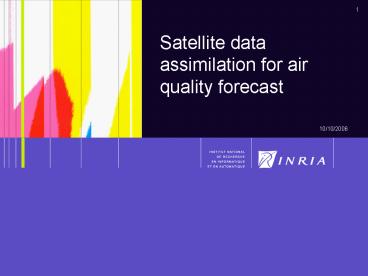Satellite data assimilation for air quality forecast - PowerPoint PPT Presentation
Title:
Satellite data assimilation for air quality forecast
Description:
PI of ESA/Eumetsat project. ... ESA operational inversion algorithm SA-NN, developed by IPSL/SA. ... At Clime team: ESA projects (EPS MetOp, TRAQ proposal) ... – PowerPoint PPT presentation
Number of Views:46
Avg rating:3.0/5.0
Title: Satellite data assimilation for air quality forecast
1
Satellite data assimilation for air quality
forecast
10/10/2006
2
Objectives
- Assimilation of satellite measurements of
troposphere chemistry, in view of improving the
quality of forecast. - Context
- Feasibility study concerning the future sensors
GOME2 and IASI (to be launched in Oct 2006 on
EPS/MetOp). PI of ESA/Eumetsat project. - Future mission TRAQ (2012) for the evolution of
air quality at regional (Europe) and global
scales. - Collaboration with IPSL/SA (C. Clerbaux)
participated to the design of the IASI sensor.
3
Chemical measurements to be assimilated
- Ground-based monitoring network
- Operated locally.
- Irregularly scattered throughout Europe, good
temporal sampling. - Non uniform quality.
- Nature ground level concentrations, vertical
profiles (LIDAR). - Satellites
- Continuous improvement of satellite measurements
of troposphere chemistry MOPITT, OMI (NASA),
GOME, SCIAMACHY (ESA), futurs GOME2 and IASI
(ESA). - Regular spatial sampling (12 km), 1
acquisition/day, uniform quality. - Nature columns (O3, NOx, CH4, ), vertical
profiles (O3, NOx), aerosols optical properties.
4
Potential of IASI acquisitions
- Considered measure 0-6km ozone column.
- What information it carries of the boundary
layer? Contribution of boundary layer ozone to
the column. - Sensitivity (via model) of boundary layer O3 to
modifications of upper troposphere O3. - IASI assimilation experiments.
5
Contribution of boundary layer ozone
- Computed from a reference atmosphere Polyphemus
analysis, July 2001. - Mean contribution 14, larger during day than
during night. - Irregularly scattered in space and time.
- Small but not negligible.
0h
15h
6
Sensitivity to modification of upper troposphere
ozone
- Experiment
- Perturbation of reference modification of O3
above 1500m. - Perturbation of initial condition, or cyclic
perturbation (simulating the assimilation of IASI
data). - Boundary layer O3 computed from Polyphemus and
compared to the reference. - Conclusions
- Sensitivity app. 25.
- Maximum impact on boundary layer observed 27h
hours after perturbation. - A better control of upper troposphere ozone
(obtained by assimilating IASI data) makes it
possible to improve the ozone forecast in the
boundary layer.
7
Assimilation of simulated IASI data
- Simulation of IASI data
- Atmosphere description (Polyphemus from 0 to 5km,
standard atmosphere above). - Simulation of radiation radiative transfer model
LBLRTM (AER). - Simulation of raw measurements (radiances) IASI
instrument model, provided by IPSL/SA. - ESA operational inversion algorithm SA-NN,
developed by IPSL/SA. - Assimilation by Optimal Interpolation in a
perturbated model
8
Examples of simulated IASI measurements
Error on 0-6km O3 column mean 27, instead of
expected 20.
Raw measurement IR radiation spectrum
9
Assimilation of simulated IASI data
- -red reference.
- -black perturbated model, mean error 13
- NO2 emissions 30
- O3 deposition -15
- O3 boundary conditions 15
- -green with assimilation, mean error 9
10
Conclusion
- -Yes, IASI can be used for improving air quality
forecast - Small but significative contribution on boundary
layer O3 to the measurement. - Good sensitivity of boundary layer O3 to a
control of upper troposphere O3. - Encouraging assimilation experiments, despites
the simulation of data and simple assimilation
method. - -Better results expected with NOx measurements
OMI, GOME2. - -Hot topic in the community.
- -At Clime team ESA projects (EPS MetOp, TRAQ
proposal), collaboration with IPSL/SA.































